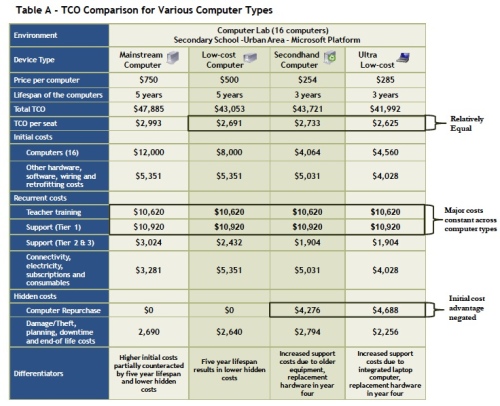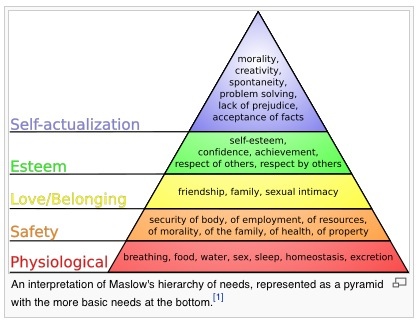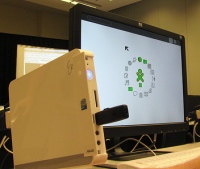Increased Computing Saturation Requires Cost Effective Solutions
In Walter Bender’s previous post, For Real Learning, Mobility and Saturation Matter, one of his concluding statements was:
“I echo Dukker in being supportive of whatever means we can deploy to get great software into the hands of children, inexpensively.”
I completely agree. Shared computing vs. 1:1 is a false dichotomy. Is it better for every student to have a computer at their fingers at school and at home? Absolutely. But pushing 1:1 as the short-term objective vs. long-term goal sets up unrealistic expectations with schools and governments that just don’t have the funding.
Is increased saturation of computing devices better?
Yes, but that can only happen with ultra-low cost solutions. Mr. Bender commented that he would leave the math to me, so let me provide a few tools and references (there are many available).
Vitalwave Consulting, a research firm that specializes in information and communications technology (ICT) in emerging markets, produced a report titled Affordable Computing for Schools in Developing Countries: A Total Cost of Ownership (TCO) Model for Education Officials that compared TCO for various platforms. Below is a summary:

The key is the Total TCO, which ranges from $2.6K to $2.9K per seat over 5 years. This dwarfs the acquisition price of $285 to $750. That is why many have criticized Nicholas Negroponte’s infamous target of a $100 laptop as unrealistic and misleading.
Unfortunately, alternative computing models, such as virtual desktops were left out of the report. According to a Vitalwave source, they included NComputing in the initial analysis but the sponsor of the report asked to keep these results hidden.
NComputing also has a comprehensive TCO Calculator (.xls file). It shows:
- The initial cost for a virtual desktop solution (assuming 16 seats) was about $4,500, which is about 60% below a mainstream desktop and about comparable with an “ultra-low cost” platform (e.g., a netbook).
- NComputing devices consume 1 or 5 watts (significantly lower than desktops and comparable to netbooks)
- Maintenance and support savings are significant. With only 3 PCs supporting 16 users, savings are about 80%,or about $550 per seat over 5 years. That’s another 20% savings vs. netbooks.
Conclusion: the math matters. To increase saturation, whether through 1:1 computing or shared access, alternative computing models must be considered.
Is mobility essential?
I think that’s debatable and really depends on the age, level of education, specific learning application required, and most importantly, where the school and community are in the spectrum of funding and specific needs.
In Maslow’s famous hierarchy of needs model, basic needs such as food or water must be fulfilled before other things are needed. For example, if one is starving (physiological), one has no interest in things like self-esteem or achievement (Esteem). They just want food.

Mr. Bender said,
“21st century computer skills” seem to be about the acquisition of some specific knowledge – necessary but not sufficient. Learning is about the acquisition of a new “outlook” – what we are capable of doing with that knowledge .
Again, I would look to a hierarchy of needs based on key demographics see if acquiring “a new outlook” is truly necessary. I’d argue that in some areas, just getting access to a computer gives that student an advantage over someone that leaves school to start working without ever having that access.
Mr. Bender uses examples where netbooks can be more advantageous in music, nature, gym, and photography. These are wonderful examples. But are these subjects relevant when we’re talking about kids that can get a great advantage just by improving their math, reading and writing courses with computers?
Students in a particular location can get a big benefit just by being exposed to computing for the first time which allows them to:
- learn how to use them
- get access to the information economy, and
- improve the quality of their learning experience through computer-based learning solution (like Sugar).
Can desktop solutions and mobile solutions co-exist?
Yes, and there are many examples where schools deploy both. In Macedonia, NComputing deployed over 100,000 virtual desktops which made Macedonia the country with the greatest density of computers to students. But Macedonia also issued a tender to deploy a smaller quantity of netbooks. They cannot afford mobility for all students, and yet even at 1:1 desktop computing they see the advantages of mobility. But emphasizing mobility is misleading and can lead public officials to trade off higher saturation and access for a mobile solution.
Sugar desktop
This last weekend, I downloaded and loaded Sugar on Stick on my laptop. I was impressed. I commend Sugar Labs for developing a remarkably simple, clean and robust learning platform. Its simplicity reminds me in many ways of Google Chrome.
And I can see the benefits of the enhanced analytical learning that could take place with this platform. But since Sugar is platform-agnostic, you don’t need a mobile solution to get it’s benefits. It could be just as easily deployed on desktop computers or virtual desktops.
Conclusion
To summarize my overall points:
- Access to a computing device can enhance education.
- The computing device is merely a tool.
- Affordability and economics are critical elements to maximize saturation.
- Increasing saturation is a good thing.
- Mobility is also beneficial, but can be expensive.
I think Walter and I share the same simple goal: improving lives and education through increasing access to ICT. This implies increased saturation.
To achieve this goal, TCO costs of deploying computing devices must be significantly lowered by 2 to 3X, and private and public sector must collaborate. More time collaborating and less time debating or competing would clear the way for significant progress.


With your reference to In Maslow’s hierarchy of needs, are you're saying that Walter may be overstepping the students' real needs when he looks to change the educational paradigm from memorization to exploration? That sticking closer to an incremental change in education using technology (ie. teaching it as a skill, like maths, rather than using it to change pedagogy), is a more achievable goal?
On the face of it, I think I agree with you there. Trying to go from instructionist to Constructionist at the same time as going from paper to digital may be too great a leap for educational systems – systems not known for their flexibility and adoption of innovation to begin with. But shouldn't we start that change somewhere? And doesn't an investment in computing offer the best opportunity to do so? If not now, when, if ever, will there be the opportunity for change?
This is a great article, thank you. I'm happy to see someone else looking at TCO rather then just low price tags.
Computer labs in a schools I've been to seem to give each kid about an hour a week. Even if you add more computers, there is only so much time the kids are in school. Plus while they are in school they have a trained, paid teacher, is it really a good use of resources to have time with the teacher replaced by time with the computer? It seems more cost efficient to use computing to extend learning time into out of school time. Mobility gives you that but as you point out, giving each kid a laptop is expensive.
Sugar on a Stick should make mobility cheaper. If kids take their sticks with them they can use them on clusters of computers in day care centers, community centers and at home if the parent has a computer. Thus by using computers in different places in their environment they can get quite a bit more hours of computing time per week and their desktop and all their work is mobile. I wonder if we can run numbers on that type of solution, and maybe instead of running them per machine, run the numbers to compare $ per hour the child uses a computer.
Is there any detail about what the support costs involve for this study? With Sugar on a Stick if there is a software problem a tech does not have to go to the computer, the student can bring the stick to the office and get a new one. Computers do not even need harddrives. This might bring down the maintenance costs.
@mbeckford – I certainly agree the user data is valuable! The code for the XS to be able to backup and restore the contents of each student's stick is currently in testing and I hope to deploy it at our pilot in the next few weeks. The XS is the open source server software for a Sugar deployment.
On maintenance cost, I think the question is how much of the maintenance costs are spent fixing hardware issues and how much supporting the software. The computer hardware maintenance (except perhaps for hard drive failures, as you no longer actually need a harddisk) should stay the same per machine, but software issues will be fixed by having the student take the broken stick to the office, getting a new one and restoring their data.
@Caroline – For maintenance, it is software that makes up the majority of service requests. So if you assume a fixed fee maintenance contract, then software takes up the bulk of the cost if you make that same allocation to the costs. Hardware just doesn't fail that much (moving parts fail the most as you adroitly point out regarding hard drives). A friend of mine bought a laptop a few months ago and something is wrong with the fan … it makes this grinding noise but still functions. Taking more computers out of the equation will reduce service requirements and thus cost. NComputing's support data is well below PC industry norms. We get calls on only .4% of our products shipped. So for every 1000 units, that's 4 calls. And most of them are typically installation questions, and hardware is rarely an issue as there are no moving parts in our virtual desktop terminals.